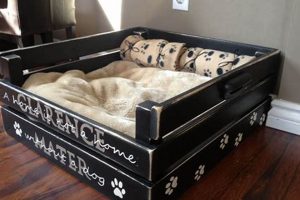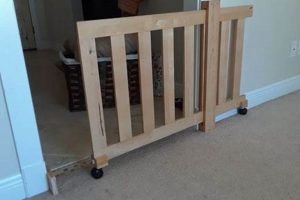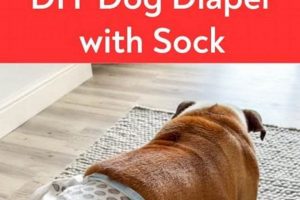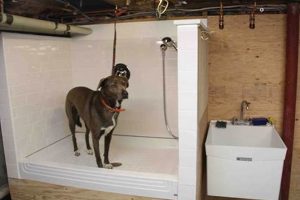Constructing a barrier at the entrance to an outdoor living space to contain canine companions involves creating a physical structure designed to prevent unsupervised departures. These enclosures offer a controlled environment for pets while allowing them to enjoy the fresh air and outdoor sights. For example, individuals seeking cost-effective and customized solutions often undertake these projects themselves, tailoring the dimensions and materials to suit the specific porch architecture and dog breed.
Implementing a containment solution at a home’s exterior entrance offers considerable advantages. It enhances pet safety by reducing the risk of escape and potential hazards such as traffic or other animals. Furthermore, it can provide peace of mind for pet owners, knowing their animals are securely within a defined space. Historically, variations of these barriers have been employed by homeowners to manage animals, adapting construction methods and materials to reflect both available resources and evolving aesthetic preferences.
The subsequent sections will examine key aspects of planning, designing, and building a durable and functional barrier for canine security, including material selection, construction techniques, and safety considerations.
Tips for Constructing a Canine-Secure Porch Barrier
The following guidelines offer considerations for individuals undertaking the construction of a barrier designed to contain dogs within a porch area. Adherence to these recommendations contributes to a secure, functional, and aesthetically appropriate outcome.
Tip 1: Precise Measurement is Paramount: Accurately measure the width and height of the porch opening before commencing any construction. This ensures a snug fit and prevents gaps through which an animal could escape. Consider any unevenness in the floor or ceiling.
Tip 2: Material Selection Affects Durability: Choose materials appropriate for outdoor exposure. Treated lumber, composite decking, or metal are resistant to weathering and decay. Select hardware, such as hinges and latches, rated for exterior use to prevent corrosion.
Tip 3: Prioritize Canine-Specific Design: The height of the barrier should be sufficient to prevent jumping, varying based on the breed and size of the dog. Ensure that the spacing between vertical members is narrow enough to prevent squeezing through.
Tip 4: Secure Mounting is Essential: Properly anchor the barrier to the porch structure. Use appropriate fasteners, such as lag screws or bolts, to ensure a robust connection. Reinforce mounting points as necessary.
Tip 5: Latch Mechanism Security Matters: Implement a secure latch mechanism that is difficult for the dog to manipulate. Consider a two-step latch or a latch that requires significant force to open.
Tip 6: Smooth Surfaces Prevent Injury: Sand all surfaces to eliminate splinters or sharp edges. Cover exposed screw heads to prevent injury. Consider the potential for chewing and select non-toxic finishes.
Tip 7: Consider Aesthetics for Harmony: Design the barrier to complement the existing porch architecture. Paint or stain the materials to match the house’s color scheme. Integrate decorative elements as desired.
Following these tips ensures the creation of a secure containment area that effectively addresses the needs of both the pet and the homeowner, while also considering the aesthetic integration of the structure with the surrounding environment.
The subsequent section will address specific design considerations that can further enhance the safety and functionality of the barrier, ensuring long-term effectiveness.
1. Accurate measurements
The success of a project designed to create a canine containment barrier at a porch entrance is directly and significantly reliant on precise dimensional readings. Inaccurate measurements, regardless of the quality of materials used or the skill of the construction, invariably lead to compromised functionality. For instance, a gate constructed with a width that is too narrow will not fit within the designated opening, rendering it unusable. Conversely, excessive width creates gaps, allowing an animal to escape, thereby negating the barrier’s intended purpose.
The implications of imprecision extend beyond simple fit. Incorrect height measurements fail to address the canine’s jumping capabilities, providing an easy avenue for evasion. Furthermore, inaccuracies compound through the construction process. For example, if the initial opening measurements are flawed, subsequent cuts and assembly will perpetuate those errors, leading to a final product that deviates substantially from the intended design. This necessitates costly rework, material waste, and a delay in achieving the desired containment solution. Imagine constructing a framework based on estimations rather than exact figures. The resulting structure is likely to be unstable, visually unappealing, and potentially dangerous to the animal.
In summary, diligent and meticulous measurement is not merely a preliminary step, but a foundational requirement for a successful canine containment barrier project. Addressing this aspect rigorously minimizes errors, ensures structural integrity, enhances the overall aesthetic, and most importantly, guarantees the safety and security of the animal. The absence of precision in this initial phase often results in wasted time, financial losses, and a failure to achieve the primary goal: a secure outdoor enclosure for the pet.
2. Durable Materials
The selection of robust components directly impacts the longevity and effectiveness of a containment structure. When constructing a barrier for canines, material choices dictate its ability to withstand both environmental stressors and the animal’s potential attempts at breaching or damaging it. For instance, using untreated wood in an outdoor setting inevitably leads to rot and decay, compromising the structural integrity of the barrier over time. Similarly, flimsy hardware, such as hinges or latches, can fail under repeated use or forceful impact, creating a security vulnerability.
Consider the implications of using pressure-treated lumber versus untreated pine. While untreated pine is readily available and inexpensive, it lacks resistance to moisture, insects, and fungal growth. A barrier constructed from this material might only last a season or two before requiring significant repairs or replacement. Conversely, pressure-treated lumber, infused with chemical preservatives, offers superior resistance to these detrimental factors, extending the lifespan of the structure considerably. Similarly, opting for stainless steel or powder-coated hardware ensures resistance to corrosion, particularly in coastal environments or areas with high humidity, ensuring reliable operation of the barrier’s moving parts.
In conclusion, the specification of durable materials is not merely a cost consideration, but a fundamental aspect of ensuring the long-term security and safety provided by a canine containment barrier. Choosing materials appropriate for the intended environment and usage patterns directly translates to reduced maintenance, enhanced reliability, and ultimately, a more effective and enduring solution for pet containment. The selection of materials therefore represents a critical decision point in the design and construction process, with ramifications extending far beyond initial budgetary considerations.
3. Canine Height
The vertical dimension of a canine is a primary determinant in the design and construction of barriers intended to contain it within a defined space, such as a porch. Specifically, in the context of constructing a containment structure, the canine’s maximum reach while standing or jumping directly dictates the minimum acceptable height of the barrier. A barrier of insufficient height represents a failure of the entire system, allowing the animal to easily circumvent the intended containment. This has direct implications for animal safety, potentially exposing the canine to hazards outside the controlled zone, such as traffic or other animals. It also undermines the purpose of the barrier, rendering it functionally useless. For example, a Great Dane, with a shoulder height potentially exceeding 30 inches and a considerable jumping reach, necessitates a substantially taller barrier than a Dachshund, which may have a shoulder height of less than 10 inches.
The practical application of this understanding involves a careful assessment of the canine’s jumping ability. While shoulder height provides a baseline, observed jumping behavior provides more accurate data. If a dog is known to jump onto furniture, the barrier height must exceed the height of the highest surface it can reach. Furthermore, the design should consider the potential for the canine to use objects near the barrier as leverage to increase its reach. For example, a storage box adjacent to the barrier could allow the dog to gain additional elevation, thus requiring the barrier to be correspondingly taller. Therefore, accurate knowledge of the specific animal’s physical capabilities and habits is paramount in determining the required height.
In summary, canine height is not merely a tangential consideration, but a central parameter governing the design and effectiveness of structures intended for animal containment. Accurately assessing this dimension and incorporating it into the barrier’s construction is essential to ensure that the intended purpose to safely and securely contain the animal within the defined space is achieved. Failure to adequately address canine height results in a compromised structure and a failure to provide the intended safety and security.
4. Secure latch
The functionality of a barrier constructed for canine containment is fundamentally dependent on the reliability of its securing mechanism. In the context of a barrier project, the latch serves as the primary defense against unauthorized egress. A compromised or inadequate latch negates the protective function of the entire structure, irrespective of the quality of materials or construction techniques employed elsewhere. The canine, if able to manipulate or overcome the latch, can freely access areas beyond the intended boundaries, potentially exposing itself to hazards and contravening the purpose of the containment system. The selection and installation of a robust, secure latch are therefore crucial elements in ensuring the effectiveness of such a structure.
Several examples underscore the practical significance of this consideration. A simple hook-and-eye latch, while inexpensive and easy to install, may be readily opened by a determined canine. Likewise, a latch positioned too low or with a handle easily gripped by a dogs paw presents a clear vulnerability. Conversely, a latch incorporating features such as double-locking mechanisms, child-resistant designs, or placement at a height beyond the dogs reach significantly reduces the risk of unauthorized opening. Furthermore, the material composition of the latch plays a critical role. Latches fabricated from corrosion-resistant metals, such as stainless steel, ensure long-term functionality even in outdoor environments, where exposure to moisture and temperature fluctuations can compromise lesser materials.
In conclusion, the secure latch component is not merely an ancillary detail, but an essential element for success in a DIY porch gate project. Its design, construction, and installation must be carefully considered to ensure effective canine containment and prevent unintended breaches of the barrier. A robust latch protects the investment of time and resources made in the project, and, more importantly, safeguard the well-being of the animal it’s intended to protect.
5. Structural Integrity
Structural integrity, defined as the ability of a structure to withstand applied loads without failure, is paramount in the construction of a porch barrier intended for canine containment. The long-term effectiveness and safety of the barrier directly correlate with its ability to resist forces exerted by the animal, environmental conditions, and normal wear and tear. Failure to adequately address structural integrity can lead to collapse, damage, or the creation of escape routes, negating the barrier’s purpose.
- Frame Stability
The frame of the structure must be robust enough to resist bending or twisting under load. This requires appropriately sized lumber or metal components, securely joined using fasteners suitable for outdoor applications. Insufficient frame stability can result in sagging, warping, or complete failure, particularly if the canine attempts to jump or lean against the barrier.
- Joint Strength
The points where individual components connect represent critical stress concentrations. Joints must be designed and constructed to withstand tensile, compressive, and shear forces. Examples include using screws or bolts instead of nails, reinforcing corners with metal brackets, and employing proper joinery techniques to maximize surface area contact and adhesive strength.
- Material Properties
The inherent strength and stiffness of the materials used directly influence the overall structural integrity. Choosing materials resistant to rot, insect damage, and corrosion is essential for long-term performance. Employing pressure-treated lumber, composite materials, or coated metals significantly enhances the barrier’s ability to withstand environmental degradation and maintain its structural integrity.
- Anchoring Security
The manner in which the gate is secured to the existing porch structure is key to the barriers overall performance. Anchors must be rated to withstand the expected pull-out force from the dog. This may mean utilizing heavy-duty screws or bolts attaching into the framing of the porch not simply the surface decking. Proper anchoring is especially critical if the barrier is a full enclosure that must resist significant lateral force.
The aforementioned facets highlight the interdependent nature of structural integrity components within a canine containment barrier. From the initial material selection to the final anchoring of the structure, each element contributes to the overall ability of the barrier to perform its intended function safely and effectively. The investment in robust materials and sound construction techniques directly translates to a more reliable and durable solution for pet containment.
6. Weather Resistance
Weather resistance is a crucial consideration in the design and construction of a barrier intended for canine containment on a porch. The prolonged exposure to environmental elements necessitates careful selection of materials and construction techniques to ensure longevity and continued functionality. Failure to address weather resistance can result in structural degradation, material failure, and ultimately, a compromised containment system.
- Material Selection
The choice of materials directly impacts a barrier’s ability to withstand weather-related damage. For example, untreated wood is susceptible to rot, insect infestation, and warping when exposed to moisture and sunlight. Conversely, pressure-treated lumber, composite materials, or naturally weather-resistant species such as cedar or redwood offer enhanced protection against these elements. Similarly, metal components should be corrosion-resistant, achieved through galvanization, powder coating, or the use of stainless steel. Appropriate material selection minimizes the need for frequent repairs or replacements, extending the lifespan of the barrier.
- Protective Coatings
Application of protective coatings further enhances a barrier’s weather resistance. Paints, stains, and sealants create a barrier against moisture penetration, UV radiation, and temperature fluctuations. For example, exterior-grade paints formulated with UV inhibitors protect wood from fading and cracking caused by prolonged sun exposure. Sealants applied to joints and seams prevent water infiltration, mitigating the risk of rot and decay. Regular maintenance and reapplication of these coatings are essential to ensure continued protection over time.
- Drainage Considerations
Proper drainage is crucial to prevent water accumulation, which can lead to rot, corrosion, and structural damage. Incorporating design features that promote water runoff, such as sloping surfaces or drainage holes, minimizes the risk of water damage. For example, ensuring that the base of the barrier is elevated slightly above the porch floor allows water to drain away freely. Similarly, avoiding enclosed spaces where water can pool prevents the development of damp conditions that foster fungal growth and material degradation.
- Joint Design
The design and construction of joints significantly influence a barrier’s resistance to weather-related stresses. Properly sealed and reinforced joints prevent water infiltration and minimize the risk of structural failure due to expansion and contraction caused by temperature fluctuations. For example, using waterproof adhesives and sealants in conjunction with mechanical fasteners ensures a tight and durable connection. Employing joinery techniques that allow for slight movement accommodates expansion and contraction, preventing cracking or warping. Attention to joint design enhances the overall weather resistance and longevity of the barrier.
The aforementioned facets underscore the critical role of weather resistance in the successful creation of a porch barrier for canine containment. Addressing these considerations through careful material selection, protective coatings, drainage design, and joint construction ensures that the structure withstands the rigors of outdoor exposure, providing a safe and secure enclosure for the animal for years to come.
7. Aesthetic integration
Aesthetic integration, in the context of constructing a canine containment barrier for a porch, refers to the harmonization of the new structure with the existing architectural style and landscape design. Achieving effective aesthetic integration ensures that the barrier does not appear as an incongruous addition, but rather as a seamless extension of the home’s design.
- Material Compatibility
Material compatibility involves selecting building materials that complement the existing porch and house. For example, if the porch features wooden railings, utilizing similar wood species and finishes for the barrier ensures a cohesive look. In contrast, introducing dissimilar materials, such as bright metal against a rustic wooden structure, can detract from the overall aesthetic. Proper material matching extends to hardware selection, ensuring that hinges and latches are visually consistent with the existing architectural details. The implications of this facet relate directly to the overall perceived value and visual appeal of the property.
- Color Coordination
Color coordination entails matching the color scheme of the barrier to the existing house and porch. Selecting a paint color or stain that complements or matches the primary and accent colors of the house minimizes visual dissonance. Considerations extend to trim colors and any existing decorative elements. For example, if the house features white trim, incorporating white trim into the barrier design maintains a consistent visual theme. Deviations from the existing color palette can create a visually jarring effect, detracting from the overall curb appeal. Effective color coordination enhances the perceived unity of the structure and its surroundings.
- Style Consistency
Style consistency refers to aligning the design of the barrier with the architectural style of the house. For example, a Victorian-style home benefits from a barrier incorporating ornate details and curved lines, whereas a modern home is better suited to a minimalist design with clean lines and simple shapes. Introducing stylistic elements that clash with the existing architecture can create a visually discordant effect. Maintaining consistency in design details, such as railing styles, post caps, and decorative accents, contributes to a harmonious and integrated appearance. Attention to style consistency ensures that the barrier appears as a deliberate and well-considered addition, rather than an afterthought.
- Scale and Proportion
Scale and proportion involve designing the barrier with dimensions that are appropriate for the size and proportions of the porch and house. A barrier that is too tall or too imposing can overwhelm the existing structure, while a barrier that is too small may appear insignificant or ineffective. Careful consideration of the height, width, and spacing of the barrier elements ensures that it is visually balanced and proportional to its surroundings. For example, a tall, narrow barrier on a small porch can create a cramped and unbalanced appearance. Maintaining appropriate scale and proportion contributes to a visually pleasing and integrated design.
These considerations collectively contribute to the overall aesthetic integration of a structure. When effectively implemented, they ensure that the containment solution fulfills its primary function of canine security without compromising the visual appeal of the property. Ignoring these elements results in a structure that, while potentially functional, detracts from the aesthetic value of the home.
Frequently Asked Questions
The following questions address common concerns regarding the construction and implementation of barrier solutions designed for canine containment on residential porches.
Question 1: What is the recommended height for a barrier intended to contain canines?
The appropriate height is contingent upon the breed and jumping capability of the specific canine. A minimum height exceeding the dog’s maximum reach when standing or jumping is advised. Observation of the animal’s jumping habits provides valuable data.
Question 2: What materials are best suited for constructing a weather-resistant barrier?
Pressure-treated lumber, composite decking, and metal (galvanized or powder-coated) are suitable materials due to their resistance to moisture, insects, and corrosion. Selection should align with the existing architectural style.
Question 3: How can the security of a barrier latch be enhanced?
Implementation of a two-step latch mechanism, or positioning the latch at a height inaccessible to the dog, can increase security. Material selection is also crucial, corrosion resistant metals are preferable.
Question 4: What safety precautions should be taken during construction?
Sanding all surfaces to eliminate splinters, covering exposed screw heads, and using non-toxic finishes are essential safety measures. Attention to detail minimizes the risk of injury to both humans and animals.
Question 5: How is structural integrity ensured in a barrier?
Employing appropriately sized lumber or metal components, securely joining them with suitable fasteners, and reinforcing corners with metal brackets contribute to structural integrity. Proper anchoring to the porch structure is also critical.
Question 6: How can the barrier’s design be integrated with the existing porch architecture?
Matching the barrier’s materials, color scheme, and style to the existing house and porch is crucial. Consideration should be given to scale and proportion to ensure a visually harmonious and integrated appearance.
Proper planning, material selection, and construction techniques are essential when creating a functional, safe, and aesthetically pleasing canine containment barrier.
The subsequent section will explore alternative designs.
Conclusion
The preceding analysis has explored key considerations in constructing a DIY porch gate for dogs. Emphasized elements include material selection predicated on weather resistance and canine behavior, secure latch mechanisms, structural integrity, and aesthetic integration with existing architecture. These design parameters contribute to a functional, safe, and visually appropriate solution for pet containment.
Implementing a self-constructed barrier requires diligence in planning and execution. Prioritizing safety, structural soundness, and harmonious design assures long-term efficacy. Prospective constructors are encouraged to carefully evaluate specific needs and consult relevant resources to achieve a positive outcome.







